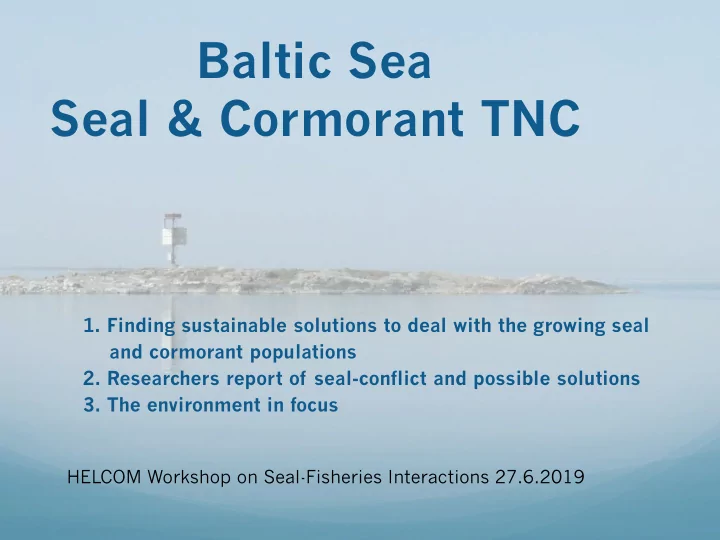

Baltic Sea Seal & Cormorant TNC 1. Finding sustainable solutions to deal with the growing seal and cormorant populations 2. Researchers report of seal-conflict and possible solutions 3. The environment in focus HELCOM Workshop on Seal-Fisheries Interactions 27.6.2019
In co-operation with 14 FLAGs we map out real damage experienced by the fishermen, and look for functional solutions to the seal and cormorant problems in the Baltic Sea area. The solutions are to be ecologically, socially and economically sustainable.
Preliminary findings The impact of seals and cormorants on the Baltic Sea commercial fisheries Esko Taanila and Anna Kääriäinen Baltic Sea seal and cormorant TNC-project Pekka Salmi, Kristina Svels and Juhani Mellanoura Natural Resources Institute Finland (Luke) BALTFISH Symposium 20th March 2019 The preliminary findings indicated in this presentation should not be cited without permission from Luke
Material and methods Structured face-to-face interviews with commercial fishermen in 6 countries Interviews were conducted in 15 study areas by 17 interviewers 15 page questionnaire Final sample: 219 fishermen BALTFISH Symposium 20th March 2019 The preliminary findings indicated in this presentation should not be cited without permission from Luke
Gross earnings Less than 10 000 € 14 10 000 - 19 999 € 29 20 000 - 39 999 € 21 At least 40 000 € 23 No answer 3 90 Total FINLAND Average 36 747 € Less than 10 000 € 18 10 000 - 19 999 € 11 20 000 - 39 999 € 21 At least 40 000 € 14 No answer 20 Total 84 SWEDEN Average 36 544 € BALTFISH Symposium 20th March 2019 The preliminary findings indicated in this presentation should not be cited without permission from Luke
Share of fishing income of the total personal income 0 - 29 % 14 30 - 79 % 33 80 - 100 % 42 Not known 1 Total 90 FINLAND Average 66% 0 - 29 % 23 30 - 79 % 27 80 - 100 % 23 Not known 11 Total 84 SWEDEN Average 53% BALTFISH Symposium 20th March 2019 The preliminary findings indicated in this presentation should not be cited without permission from Luke
The gravity of seal and cormorant induced impacts to interviewee’s fishing livelihood in study areas Indexes show how serious the impacts were assessed by the fishers The preliminary findings indicated in this presentation should not be cited without permission fromLuke
The gravity of seal induced impacts to the interviewee’s fishing livelihood in Finland divided in six impact categories, % (n=89) BALTFISH Symposium 20th March 2019 The preliminary findings indicated in this presentation should not be cited without permission from Luke
The average seal and cormorant induced losses estimated by the fishermen FINLAND Seal 19 930 € (n= 77) Cormorant 5 993 € (n= 52) SWEDEN Seal 22 064 € (n=67) Cormorant 5 667 € (n=42) The preliminary findings indicated in this presentation should not be cited without permission from Luke
Researchers report of the seal problem and solutions The impact of growing seal population 1. Direct impact on fisheries including catch losses and damaged fishing gear due to seal depredation. 2. Fish consumption of seals that affects the fish populations 3. Spreading parasites harmful to man and fish
1. The impact on fisheries Catch losses and damaged fishing gear due to seal depredation. Damage in active fishery about 20.000 € /year/fisherman: BSSC-project Cod fishery: average 5 fish lost for each fish found damaged
2. Fish consumption of seal Seals consume large quantities fish, it should to be carefully considered in ecosystem analyses and stock assessment models. Especially in costal fishery 100 milj kg/year 2% salmon = 2 milj kg salmon every year (Ecoseal) 35% high value fish (salmon, perch, pike perch, whitefish) in Gulf of Finland (Ecoseal)
3. Spreading parasites harmful to man and the fish The seal worm Psudoterranova decipiens The liver worm Contracaecum osculatum .
Conclusions All these three aspects of the conflict are alarming. Correlation between the size of the seal population and the level of the conflict. The seal fisheries conflict is one of the small-scale fisheries main concerns and does not only affect the subjected fisheries, but also the local coastal communities, the ability to meet public access to local fish and even the ecosystem.
Mitigation measures There is a need of a dramatic change in Baltic Sea seal management The HELCOM seal recommendation should take to account both socioeconomic and ecological aspects in seal management as proposed in The Habitats Directive. Seal-safe fishing gear or other methods such as scaring devices to decrease the catch loss and damage to fishing gear are important but not sufficient measures when considering the magnitude of the problem
In practice Change in EU-ban of trade of seal products There is an urgent need to start managing seal population with hunting to reduce the population increase
Enviroment in focus Seals eat about 100 milj kg fish yearly ( 5-7 kg/day) 2% salmon 35% high value fish (Gulf of Finland) Baltic Sea coastal fishery 52 milj kg ( half of seals consumption) (STECF 2016) The value of local catched fish Local or imported ( now 4 of 5 fish are imported) Fresh, near produced and healthy food, Socioeconomc effects on the coastal livelihood Fishing reduces significant ammounts of phosphorus and nitrogen from the eutrophic Baltic Sea Balance between small scale fishery – seal stock -environment
Recommend
More recommend